This post is to reassure any groups or individuals who come across my blog that there is no lasting damage to the becks and no wildlife is ever disturbed. If there are signs of life ie Voles or even rats the area gets left alone.
As for the becks themselves any excavations are out of sight, and done in such a manor that the natural flooding of the beck will restore any area back as it was, in the main i choose areas that have recently collapsed naturally therefore not changing the natural course of the becks.
One thing i have noticed that may be of interest to people involved with the wildlife of the becks is wherever i see these ancient deposits exposed, ie the river gravels clays some laminated some not, Voles and other small mammals have had no interest in digging into now or in the past, the material is probably to tough to get through.














































 This stretch of Marton west beck has by far the largest deposits of Andesite dyke stone i have found anywhere in the south Cleveland area, the gravel layers in the beck banks are full of it, and all tested were magnetic.
This stretch of Marton west beck has by far the largest deposits of Andesite dyke stone i have found anywhere in the south Cleveland area, the gravel layers in the beck banks are full of it, and all tested were magnetic.








